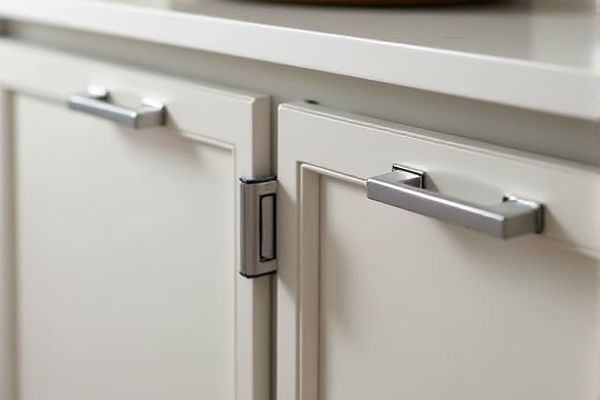
Soft-close hinges reduce noise and prevent cabinet doors from slamming shut by incorporating a built-in damping mechanism, whereas standard hinges lack this feature, resulting in louder and more abrupt closures. Explore the rest of the article to understand which hinge option best suits Your cabinetry needs and enhances your home's functionality.
Table of Comparison
| Feature | Soft-Close Hinges | Standard Hinges |
|---|---|---|
| Closing Mechanism | Automatic slow and silent closure | Manual, no controlled closing |
| Noise Level | Quiet, reduces slamming noise | Can produce loud slamming sounds |
| Durability | Higher lifespan due to reduced impact | Prone to faster wear from slamming |
| Installation | Slightly more complex, requires precise adjustment | Simple installation, basic adjustment |
| Cost | More expensive upfront | Lower initial cost |
| Common Use | Modern kitchens, bathrooms, high-end furniture | General cabinetry, budget furniture |
| Maintenance | Low, occasional lubrication needed | Low, but may require tightening over time |
Introduction to Hinges: Soft-Close vs. Standard
Soft-close hinges provide a controlled, quiet closing mechanism that prevents doors from slamming, enhancing durability and reducing noise in your home or office. Standard hinges offer a basic pivot function without any noise dampening, making them more affordable but less effective in preventing wear and tear. Choosing soft-close hinges improves the longevity of cabinetry while adding a modern, user-friendly feature to your furniture.
What are Soft-Close Hinges?
Soft-close hinges are specialized hardware designed to prevent cabinet doors from slamming shut by using integrated hydraulic or pneumatic dampers, ensuring smooth and silent closing. Unlike standard hinges that simply pivot, soft-close hinges gently control the final movement, reducing wear and noise. By choosing soft-close hinges, your cabinets experience enhanced durability and improved user experience with quieter operation.
What are Standard Hinges?
Standard hinges are basic mechanical components that connect doors to frames, allowing for smooth pivoting motion without built-in dampening features. Typically made from steel or brass, these hinges come in various sizes and styles, including butt hinges and continuous hinges, and are widely used in residential and commercial applications. They provide straightforward functionality but lack the noise-reducing and slow-closing benefits found in soft-close hinges.
Key Differences Between Soft-Close and Standard Hinges
Soft-close hinges feature a hydraulic damper that gently slows the door, preventing slamming and reducing noise, while standard hinges lack this mechanism and allow doors to close abruptly. Soft-close hinges enhance cabinet longevity by minimizing wear and tear, whereas standard hinges may contribute to faster deterioration from repeated impact. Installation of soft-close hinges typically requires compatibility with specific cabinetry designs, unlike the more universally adaptable standard hinges.
Benefits of Soft-Close Hinges
Soft-close hinges provide enhanced safety by preventing doors from slamming shut, reducing noise and minimizing wear on cabinetry. These hinges extend the lifespan of your furniture by cushioning the closing motion and protecting hinges and doors from damage. Installing soft-close hinges improves user experience with smooth, controlled closing, making your kitchen or storage space more comfortable and durable.
Advantages of Standard Hinges
Standard hinges offer affordability and ease of installation, making them a practical choice for budget-conscious projects. Their simple design ensures durability and requires minimal maintenance over time. Standard hinges provide reliable support for a wide range of cabinet and door types without the need for specialized hardware.
Installation Process: Soft-Close vs. Standard Hinges
Soft-close hinges typically require a more precise alignment during installation compared to standard hinges to ensure the damping mechanism functions properly. Standard hinges involve a straightforward attachment process with fewer components, making them quicker and easier to install for beginners. Installation of soft-close hinges often demands calibration of tension settings, which can extend the setup time but results in quieter, controlled door movement.
Durability and Maintenance Comparison
Soft-close hinges feature enhanced durability due to integrated damping mechanisms that reduce wear from constant slamming, extending the lifespan compared to standard hinges. Maintenance requirements for soft-close hinges are typically lower, as their smooth operation minimizes damage to cabinet frames and door edges, whereas standard hinges often need periodic realignment and lubrication to prevent squeaking and misalignment. Choosing soft-close hinges can result in longer-lasting hardware with fewer upkeep demands, especially in high-traffic kitchen environments.
Cost Analysis: Which Hinge is More Affordable?
Standard hinges generally cost between $2 to $10 per unit, making them more affordable upfront compared to soft-close hinges, which typically range from $10 to $30 each. Soft-close hinges require more complex mechanisms, resulting in higher manufacturing and replacement costs. For budget-conscious projects or large-scale installations, standard hinges offer a more economical choice without additional durability concerns.
Which Hinge is Right for Your Needs?
Soft-close hinges prevent doors from slamming shut, offering quiet and smooth operation ideal for kitchens or home offices where noise reduction is important. Standard hinges provide a more basic, cost-effective option but lack the gentle closing feature, making them better suited for less frequently used doors or budget-conscious projects. Choose soft-close hinges if you value durability and noise control; otherwise, standard hinges fulfill essential functionality at a lower price point.
 homyna.com
homyna.com